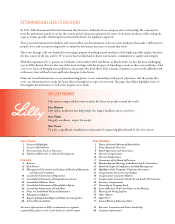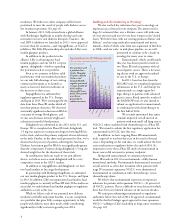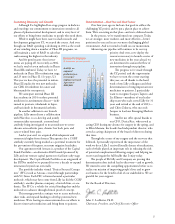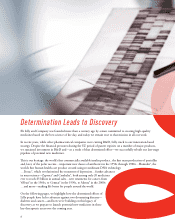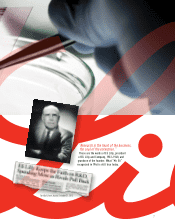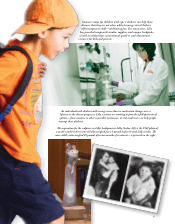Eli Lilly 2013 Annual Report Download - page 12
Download and view the complete annual report
Please find page 12 of the 2013 Eli Lilly annual report below. You can navigate through the pages in the report by either clicking on the pages listed below, or by using the keyword search tool below to find specific information within the annual report.
10
An Evolving Effort Against a Tenacious and
Deadly Foe—Cancer
In the early 1960s, Lilly played a key role in one
of the rst cancer chemotherapies: the vinca
alkaloids.
Lilly researcher Gordon Svoboda found
that an extract of the periwinkle
plant could prolong the life of
mice infected with leukemia.
Svoboda’s team isolated four
of the plant’s alkaloid mol-
ecules—out of 90—that had
active antitumor properties.
In 1958, the Lilly team
began a collaboration with
researchers at the Univer-
sity of Western Ontario
who had crystallized a par-
ticular vinca alkaloid that
seemed to have pronounced
anticancer qualities.
e result was Velban®, which
Lilly introduced commercially
in 1961 as a treatment for Hodg-
kin’s disease and choriocarcinoma. In
1963, Lilly introduced yet another periwinkle
alkaloid-derived product, Oncovin®—a breakthrough
in treating acute childhood leukemia.
e vinca alkaloids are still used as components of important
cancer treatment regimens that have proven to be curative in
some forms of the disease.
Today, we continue our work to nd new cancer treatments.
In late 2008, we acquired ImClone, which enhanced our
oncology pipeline and complemented our ongoing oncology
research eorts.
In 2013, we reported positive results in Phase III trials of
two molecules that came from the ImClone acquisition. We
submitted ramucirumab for approval in the U.S. and Europe
for patients with advanced gastric cancer, commonly known as
stomach cancer. And we announced results of a Phase III study
in which necitumumab demonstrated increased overall survival
in combination with chemotherapy, as a rst-line treatment
for metastatic squamous non-small cell lung cancer (NSCLC).
e global incidence of cancer will increase from an estimated
14 million new cases in 2012 to 22 million new cases a year within the
next two decades, according to the World Health Organization. Lilly’s
ongoing clinical efforts seek to address tumors with high unmet needs,
including lung, stomach, and colorectal cancers.


